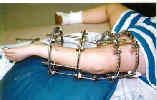- Discussion:
- musculoskeletal dz is characterized by congenital immobility of multiple joints.
- there may be as many as 10 to 20 specific arthrogrypotic disorders, all with similar joint manifestations;
- believed to be caused by oligohydrmnios & conditions limiting fetal movement;
- joint develops in arthrogryposis multiplex congenita, but periarticular soft tissue structures become fibrotic, leading to development of an
incomplete fibrous ankylosis;
- Clinical Presentation:
- affected patients typically have normal facies, normal intelligence, multiple joint contractures, and no viceral abnormalities;
- distal joints are usually affected more severely;
- classic arthrogrypotic deformities are present at birth;
- note that it is common for newborns to display mild elbow contractures, which should not be confused with arthrogryposis;
- Joint motion limitation in newborns.
- diff dx:
- myelomeningocele;
- moebius syndrome;
- larsen's sydndrome (multiple joint dislocations, esp knees);
- Pena Shokeir syndrome (growth deficiency, unusual facial features, multiple ankylosis;
- camptodactyly (when only a finger is involved);
- talipes equinovarus;
- congenital myasthenia gravis;
- whistling face syndrome;
- Initial Workup:
- evaluation should include neurologic studies, enzymes tests, and muscle biopsy (at 3-4 months);
- radiographs:
- may be needed to r/o spinal dyshaphism or DDH;
- femoral shaft frxs and epiphyseal separations can be seen in patients with fixed knee extension or dislocated hips;
- Spine: may be involved with characteristic "C" shaped (neuromuscular scoliosis)
- Upper Extremity:
- involvement usually includes adduction & internal rotation of humerus, elbow extension and wrist flexion, and ulnar deviation;
- shoulder:
- shoulders are adducted and internally rotated;
- shoulders rarely require treatment;
- in selected individuals, severe internal rotation contractures can be corrected w/ proximal external rotational osteotomy of the humerus
- elbow:
- restoration of flexion of one elbow is a primary consideration in the management of the upper extremity;
- elbows are fixed in flexion or extension
- Surgical treatment of arthrogryposis of the elbow.
- wrist: wrists are in flexion and ulnar deviation;
- in the report by Smith and Drennan, the authors report on arthrogrypotic wrist flexion contractures treated with passive stretching,
serial casting, and custom wrist orthotics to determine the effect on wrist position and function;
- 17 infant patients with distal and classic arthrogryposis used this regimen;
- greatest gain in wrist motion occurred after the first casting session for both groups;
- patients with distal arthrogryposis had the largest improvement in passive wrist motion, were more functionally
independent at final follow-up, and had no recurrence of deformity;
- patients with classic arthrogryposis had rigid wrist flexion contractures and a 75% incidence of deformity recurrence after casting;
- at final follow-up, these patients remained functionally dependent, requiring >50% assistance with activities of daily living, and had
less improvement in wrist motion;
- authors recommended early casting of infant wrist deformities for both forms of arthrogryposis;
- they noted that with recurrent wrist deformity, repeat serial casting was unlikely to improve wrist extension;
- hand in arthrogryposis:
- references:
- Arthrogryposis of the upper extremity.
- Arthrogryposis Wrist Deformities: Results of Infantile Serial Casting
- Lower Extremity:
- hips:

- hips are usually flexed, externally rotated, and abducted;
- teratologic hip dislocation is common (see DDH);
- simple closed reduction is generally not possible, and more often open reduction and femoral femoral shortening will be required;
- some surgeons feem that open reduction of unilateral hip dislocation is controversial, since these hips are often stiff and since multiple
procedures are often required to maintain reduction;
- there appears to be more of a consensus for open reduction of unilateral dislocations rather than bilateral dislocations;
- in the study by Akazawa H, et al (1998), the authors described an extensive anterolateral approach and open reduction for bilateral arthrogrypotic hip dislocation (5 patients);
- at final follow up, all children walked without crutches or canes;
- authors recommend a complete circumferential capsulotomy followed by release of all contracted soft tissues;
- references:
- The hip in arthrogryposis multiplex congenita.
- A plan of management and treatment results in the arthrogrypotic hip.
- Management of hip dislocations in children with arthrogryposis.
- Medial approach open reduction of hip dislocation in amyoplasia type arthrogryposis.
- Surgical management of hip dislocations in children with arthrogryposis multiplex congenita.
- Twenty-Year Follow-up of Hip Problems in Arthrogryposis Multiplex Congenita.

- knee:
- flexion contractures are common;
- soft tissue releases (esp hamstrings),
- knee contractures should be corrected before hip reduction in order to maintain reduction;
- in some cases, knee flexion contractures can be managed w/ an ilizarov fixator;
- foot: 

- rigid clubfeet are most common deformity (followed by CVT);
- clubfoot deformities are usually severe & is associated w/ limited ankle and tarsal motion;
- serial manipulation:
- casting in the newborn may partially correct condition but recurrence of the deformity occurs when non operative treatment is interrupted;
- talectomy:
- in children with arthrogryposis, severe equinovarus deformities are best managed with talectomy;
- primary talectomy is effective in management of severe equinovarus deformities in pts w/ arthrogryposis;
- references:
- Equinovarus deformity in arthrogryposis and myelomeningocele: evaluation of primary talectomy.
- triple arthrodesis:
- triple arthrodesis w/ limited bone resection is procedure of choice in arthrogryposis patients over 10 years old

